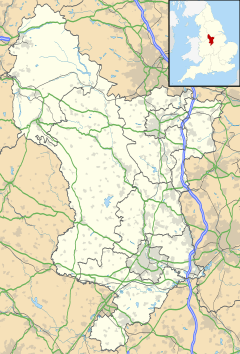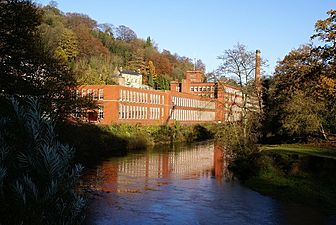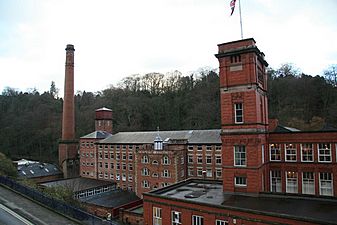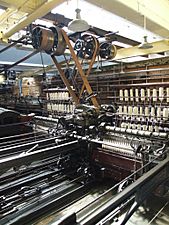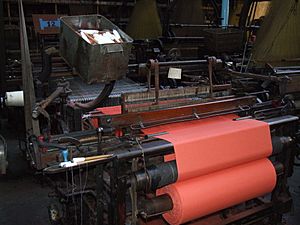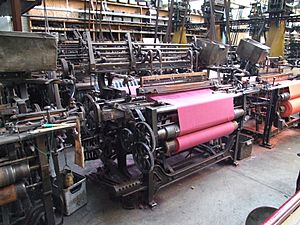Masson Mill facts for kids
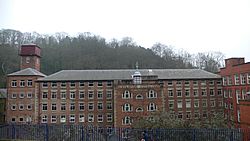
Masson Mill in 2006
|
|
| Cotton | |
|---|---|
| Spinning mill (water frame) | |
| Structural system | Brick on gritstone |
| Location | Matlock Bath, Derbyshire, England |
| Owner | Arkwright |
| Further ownership |
|
| Current tenants | Museum and retail village |
| Coordinates | 53°06′46″N 1°33′42″W / 53.1128°N 1.5616°W |
| Construction | |
| Built | 1783 |
| Renovated |
|
| Floor count | 5, of 21 bays |
| Floor area | 43.8 metres (144 ft) long and 8.4 metres (28 ft) wide |
| Design team | |
| Awards and prizes and listings | World Heritage Site |
| Water Power | |
| Wheels |
|
Masson Mill is an old cotton spinning factory in Matlock Bath, England. It sits right next to the River Derwent. Sir Richard Arkwright, a famous inventor, built this mill in 1783.
Masson Mill is a very important historical place. It is part of the Derwent Valley Mills, which is a World Heritage Site. This means it's recognized globally for its special history and culture. Near the mill, you can also find Willersley Castle, a large house that Richard Arkwright built for himself.
Contents
The Story of Masson Mill
Why Cotton Mills Were Needed
In the 1700s, people started using a new invention called the "flying shuttle" to weave cotton much faster. This meant there was a huge demand for spun cotton thread. Older machines for preparing and spinning cotton were not very good. They couldn't make strong enough thread for the main part of the fabric, called the warp.
Richard Arkwright's Big Idea
In 1769, Richard Arkwright invented a new machine called the water frame. This machine used the power of flowing water to spin cotton. It made stronger, better quality thread. His first mill using this idea was Cromford Mill in 1771. Masson Mill was his third mill. He built it nearby to use the powerful flow of the River Derwent.
Building the Mill
Masson Mill was built with strong brick and stone. The original building was 43.8 meters long and 8.4 meters wide. It had 5 floors and 21 sections. The stairs and other services were in the middle. This kept the main work areas clear, which was a clever design for its time.
How the Mill Was Powered
At first, one large waterwheel powered the mill. By 1801, two waterwheels were used. These were replaced in 1847 by new wheels from Wren and Bennet. Later, in 1928, modern turbines took over, using the river's power even more efficiently. Around 1800, the roof was raised. This added a sixth usable floor to the mill.
A special wall, called a weir, was built across the Derwent River. This weir helped to build up enough water power for Masson Mill and another paper mill. It's unusual because it curves outwards, unlike most weirs that curve inwards.
Life at the Mill
In 1840, a writer named Adams described Masson Mill. He said it was full of the best machines for making cotton thread. He also wrote about how beautiful the mill looked at night. Its many lights reflected on the river, and the sounds of the machines mixed with the waterfall.
Over the years, more buildings were added to the mill. Some parts were later removed. In 1911, 1928, and 1998, new sections were built using a special type of brick. The tall chimney and the engine house were built in 1900. These were designed by Stott and Sons, famous architects for mills.
Changes in Ownership and Use
In 1897, Masson Mill became part of a larger company called the English Sewing Cotton Company. The mill was a major employer for people living in Matlock Bath. It continued to provide many jobs for a long time.
The mill has been carefully repaired and restored in recent years. Today, Masson Mill is home to a museum. Visitors can learn all about its history and how cotton was made. It used to have a retail village with shops, but that part did not reopen after the COVID-19 pandemic.
Generating Clean Energy
Masson Mill still uses the power of water today! In 1995, hydroelectric generators were installed. These generators use the river's flow to create 240 kilowatts of electricity. This is a clean and renewable way to make power.
Gallery
- Masson Mill
- Carding and spinning
- Loom collection


